Workplace Flexibility Impact on Employee Motivation: Morrison's
VerifiedAdded on 2023/01/10
|7
|2167
|96
Literature Review
AI Summary
This literature review examines the significance of workplace flexibility in enhancing employee motivation within the retail sector, using Morrison's as a case study. It explores the concept of workplace flexibility, highlighting its importance and impact on employee motivation, drawing on Herzberg's two-factor theory and other research. The review discusses the benefits of flexible working arrangements, such as increased morale, reduced absenteeism, and improved performance, while also addressing potential drawbacks like communication errors and reduced career progression. It further identifies the challenges employers face when managing workplace flexibility, including difficulties in providing direction and assessing performance. The review concludes by emphasizing the importance of a balanced approach to workplace flexibility to maximize employee motivation and overall business success.
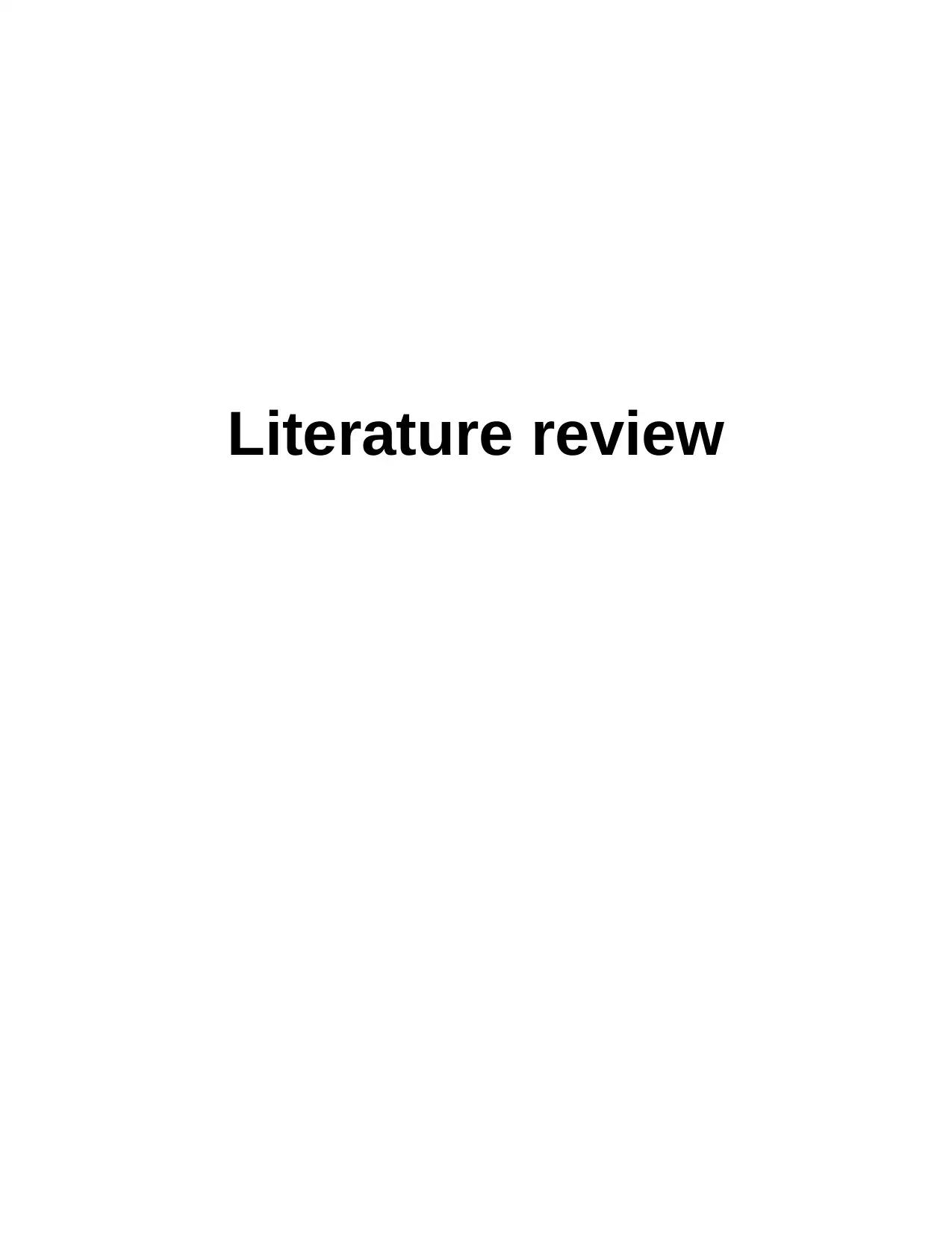
Literature review
Secure Best Marks with AI Grader
Need help grading? Try our AI Grader for instant feedback on your assignments.
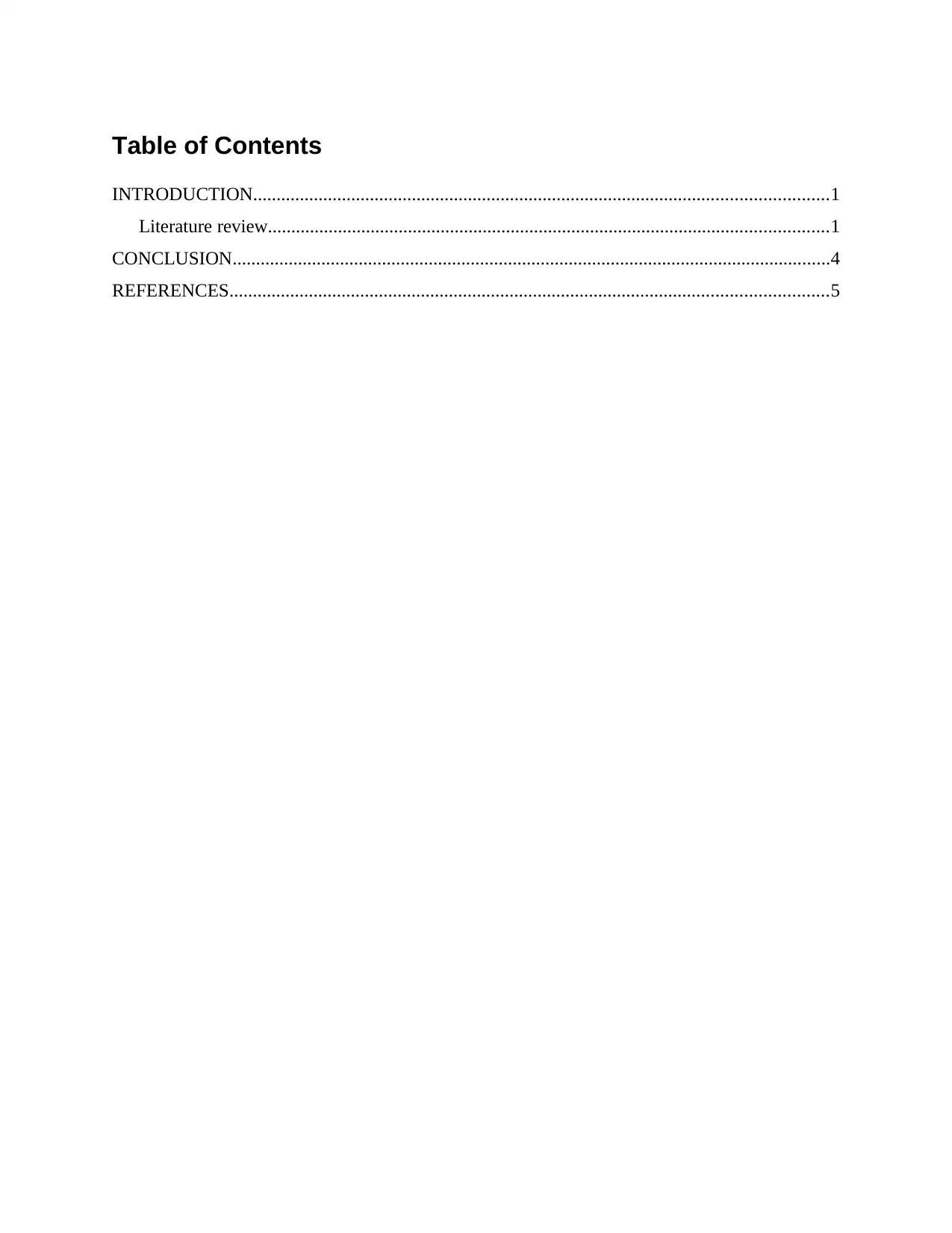
Table of Contents
INTRODUCTION...........................................................................................................................1
Literature review........................................................................................................................1
CONCLUSION................................................................................................................................4
REFERENCES................................................................................................................................5
INTRODUCTION...........................................................................................................................1
Literature review........................................................................................................................1
CONCLUSION................................................................................................................................4
REFERENCES................................................................................................................................5
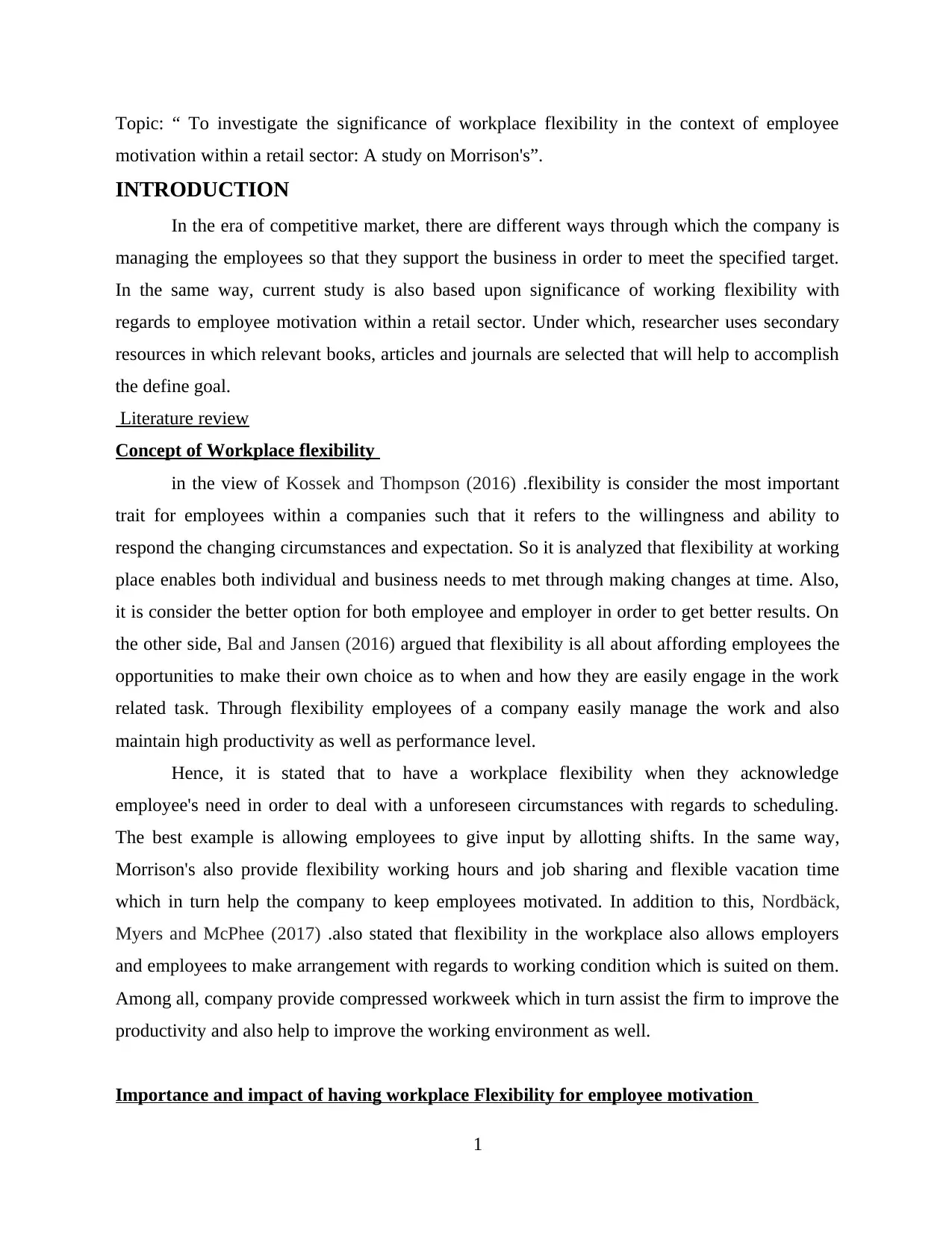
Topic: “ To investigate the significance of workplace flexibility in the context of employee
motivation within a retail sector: A study on Morrison's”.
INTRODUCTION
In the era of competitive market, there are different ways through which the company is
managing the employees so that they support the business in order to meet the specified target.
In the same way, current study is also based upon significance of working flexibility with
regards to employee motivation within a retail sector. Under which, researcher uses secondary
resources in which relevant books, articles and journals are selected that will help to accomplish
the define goal.
Literature review
Concept of Workplace flexibility
in the view of Kossek and Thompson (2016) .flexibility is consider the most important
trait for employees within a companies such that it refers to the willingness and ability to
respond the changing circumstances and expectation. So it is analyzed that flexibility at working
place enables both individual and business needs to met through making changes at time. Also,
it is consider the better option for both employee and employer in order to get better results. On
the other side, Bal and Jansen (2016) argued that flexibility is all about affording employees the
opportunities to make their own choice as to when and how they are easily engage in the work
related task. Through flexibility employees of a company easily manage the work and also
maintain high productivity as well as performance level.
Hence, it is stated that to have a workplace flexibility when they acknowledge
employee's need in order to deal with a unforeseen circumstances with regards to scheduling.
The best example is allowing employees to give input by allotting shifts. In the same way,
Morrison's also provide flexibility working hours and job sharing and flexible vacation time
which in turn help the company to keep employees motivated. In addition to this, Nordbäck,
Myers and McPhee (2017) .also stated that flexibility in the workplace also allows employers
and employees to make arrangement with regards to working condition which is suited on them.
Among all, company provide compressed workweek which in turn assist the firm to improve the
productivity and also help to improve the working environment as well.
Importance and impact of having workplace Flexibility for employee motivation
1
motivation within a retail sector: A study on Morrison's”.
INTRODUCTION
In the era of competitive market, there are different ways through which the company is
managing the employees so that they support the business in order to meet the specified target.
In the same way, current study is also based upon significance of working flexibility with
regards to employee motivation within a retail sector. Under which, researcher uses secondary
resources in which relevant books, articles and journals are selected that will help to accomplish
the define goal.
Literature review
Concept of Workplace flexibility
in the view of Kossek and Thompson (2016) .flexibility is consider the most important
trait for employees within a companies such that it refers to the willingness and ability to
respond the changing circumstances and expectation. So it is analyzed that flexibility at working
place enables both individual and business needs to met through making changes at time. Also,
it is consider the better option for both employee and employer in order to get better results. On
the other side, Bal and Jansen (2016) argued that flexibility is all about affording employees the
opportunities to make their own choice as to when and how they are easily engage in the work
related task. Through flexibility employees of a company easily manage the work and also
maintain high productivity as well as performance level.
Hence, it is stated that to have a workplace flexibility when they acknowledge
employee's need in order to deal with a unforeseen circumstances with regards to scheduling.
The best example is allowing employees to give input by allotting shifts. In the same way,
Morrison's also provide flexibility working hours and job sharing and flexible vacation time
which in turn help the company to keep employees motivated. In addition to this, Nordbäck,
Myers and McPhee (2017) .also stated that flexibility in the workplace also allows employers
and employees to make arrangement with regards to working condition which is suited on them.
Among all, company provide compressed workweek which in turn assist the firm to improve the
productivity and also help to improve the working environment as well.
Importance and impact of having workplace Flexibility for employee motivation
1
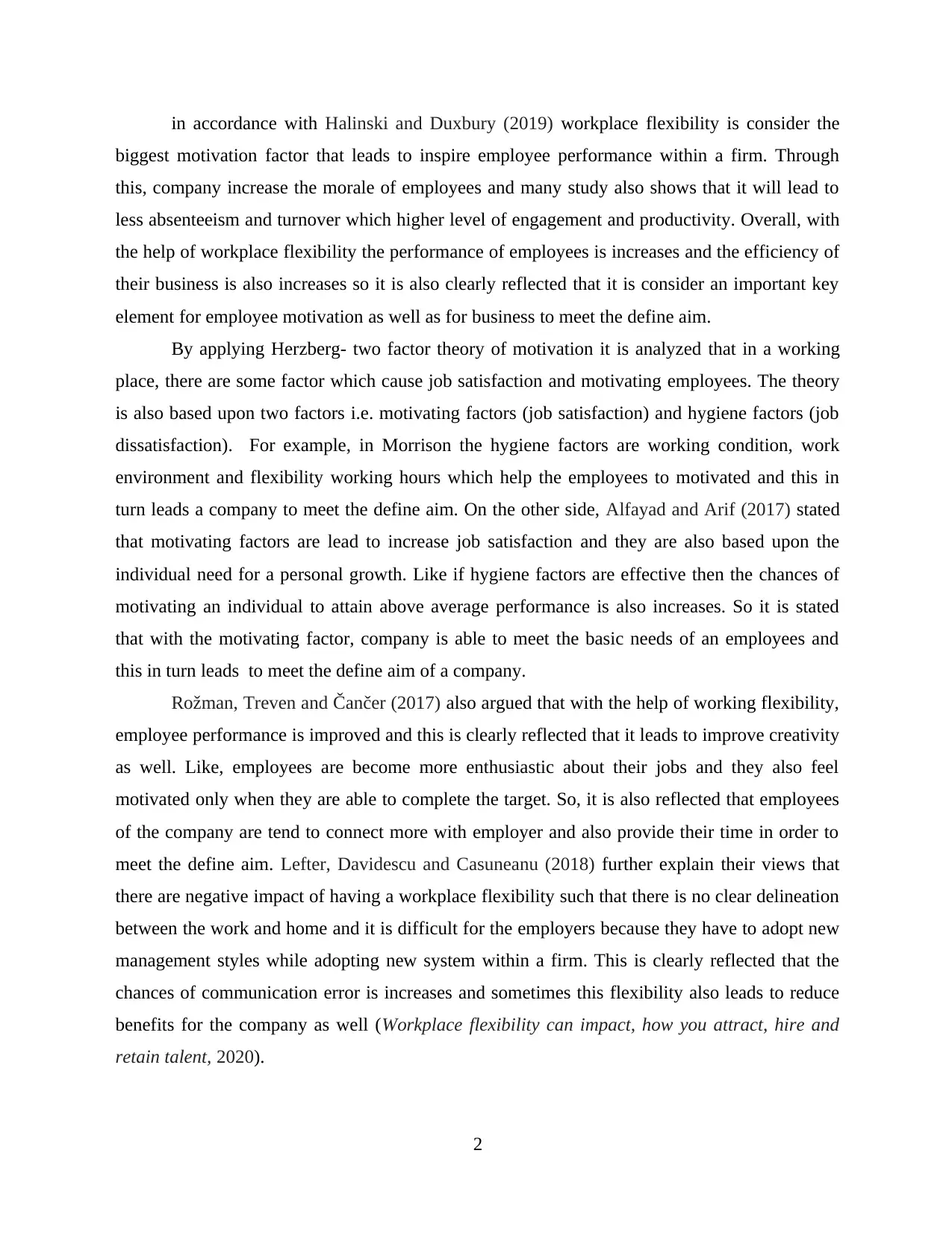
in accordance with Halinski and Duxbury (2019) workplace flexibility is consider the
biggest motivation factor that leads to inspire employee performance within a firm. Through
this, company increase the morale of employees and many study also shows that it will lead to
less absenteeism and turnover which higher level of engagement and productivity. Overall, with
the help of workplace flexibility the performance of employees is increases and the efficiency of
their business is also increases so it is also clearly reflected that it is consider an important key
element for employee motivation as well as for business to meet the define aim.
By applying Herzberg- two factor theory of motivation it is analyzed that in a working
place, there are some factor which cause job satisfaction and motivating employees. The theory
is also based upon two factors i.e. motivating factors (job satisfaction) and hygiene factors (job
dissatisfaction). For example, in Morrison the hygiene factors are working condition, work
environment and flexibility working hours which help the employees to motivated and this in
turn leads a company to meet the define aim. On the other side, Alfayad and Arif (2017) stated
that motivating factors are lead to increase job satisfaction and they are also based upon the
individual need for a personal growth. Like if hygiene factors are effective then the chances of
motivating an individual to attain above average performance is also increases. So it is stated
that with the motivating factor, company is able to meet the basic needs of an employees and
this in turn leads to meet the define aim of a company.
Rožman, Treven and Čančer (2017) also argued that with the help of working flexibility,
employee performance is improved and this is clearly reflected that it leads to improve creativity
as well. Like, employees are become more enthusiastic about their jobs and they also feel
motivated only when they are able to complete the target. So, it is also reflected that employees
of the company are tend to connect more with employer and also provide their time in order to
meet the define aim. Lefter, Davidescu and Casuneanu (2018) further explain their views that
there are negative impact of having a workplace flexibility such that there is no clear delineation
between the work and home and it is difficult for the employers because they have to adopt new
management styles while adopting new system within a firm. This is clearly reflected that the
chances of communication error is increases and sometimes this flexibility also leads to reduce
benefits for the company as well (Workplace flexibility can impact, how you attract, hire and
retain talent, 2020).
2
biggest motivation factor that leads to inspire employee performance within a firm. Through
this, company increase the morale of employees and many study also shows that it will lead to
less absenteeism and turnover which higher level of engagement and productivity. Overall, with
the help of workplace flexibility the performance of employees is increases and the efficiency of
their business is also increases so it is also clearly reflected that it is consider an important key
element for employee motivation as well as for business to meet the define aim.
By applying Herzberg- two factor theory of motivation it is analyzed that in a working
place, there are some factor which cause job satisfaction and motivating employees. The theory
is also based upon two factors i.e. motivating factors (job satisfaction) and hygiene factors (job
dissatisfaction). For example, in Morrison the hygiene factors are working condition, work
environment and flexibility working hours which help the employees to motivated and this in
turn leads a company to meet the define aim. On the other side, Alfayad and Arif (2017) stated
that motivating factors are lead to increase job satisfaction and they are also based upon the
individual need for a personal growth. Like if hygiene factors are effective then the chances of
motivating an individual to attain above average performance is also increases. So it is stated
that with the motivating factor, company is able to meet the basic needs of an employees and
this in turn leads to meet the define aim of a company.
Rožman, Treven and Čančer (2017) also argued that with the help of working flexibility,
employee performance is improved and this is clearly reflected that it leads to improve creativity
as well. Like, employees are become more enthusiastic about their jobs and they also feel
motivated only when they are able to complete the target. So, it is also reflected that employees
of the company are tend to connect more with employer and also provide their time in order to
meet the define aim. Lefter, Davidescu and Casuneanu (2018) further explain their views that
there are negative impact of having a workplace flexibility such that there is no clear delineation
between the work and home and it is difficult for the employers because they have to adopt new
management styles while adopting new system within a firm. This is clearly reflected that the
chances of communication error is increases and sometimes this flexibility also leads to reduce
benefits for the company as well (Workplace flexibility can impact, how you attract, hire and
retain talent, 2020).
2
Secure Best Marks with AI Grader
Need help grading? Try our AI Grader for instant feedback on your assignments.
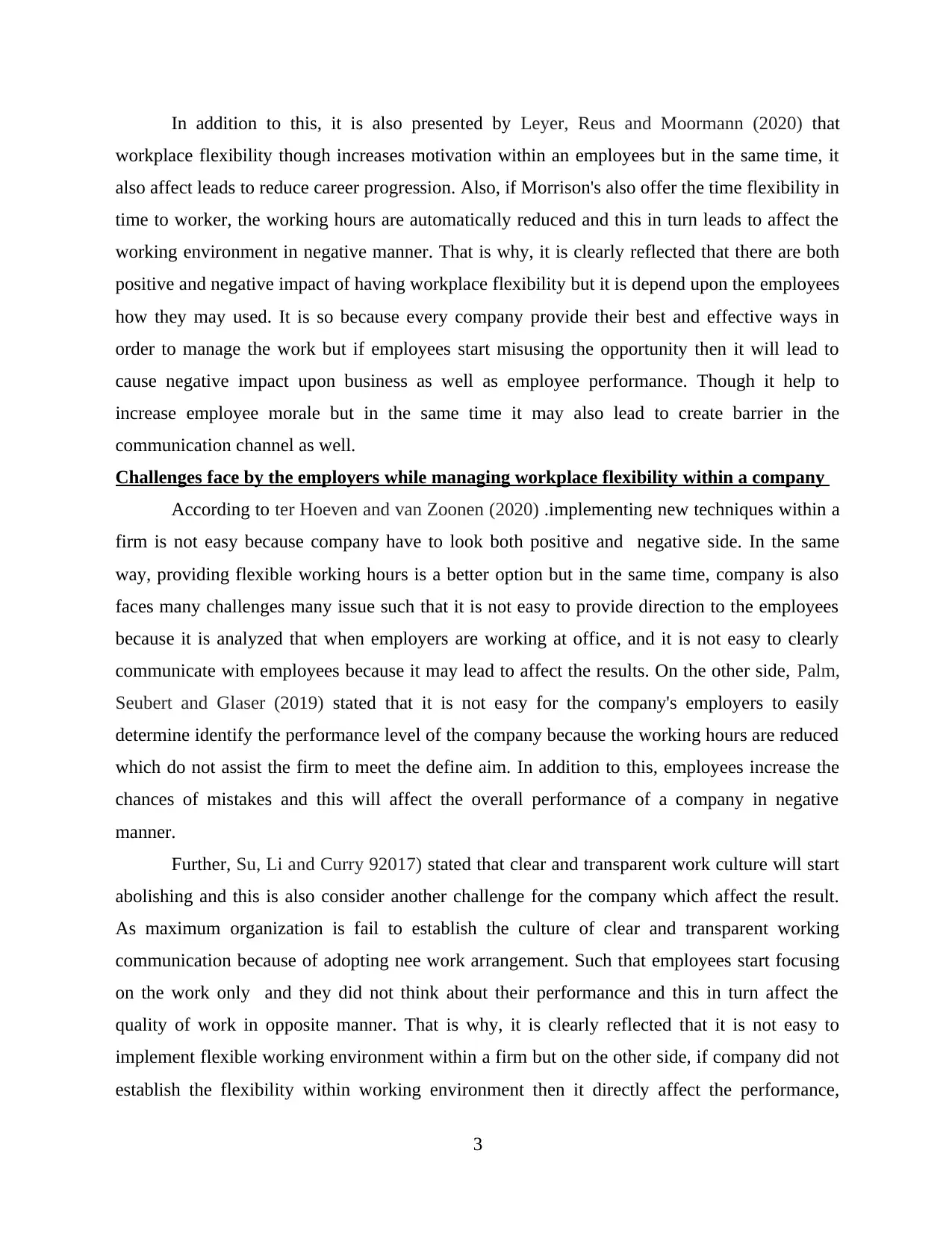
In addition to this, it is also presented by Leyer, Reus and Moormann (2020) that
workplace flexibility though increases motivation within an employees but in the same time, it
also affect leads to reduce career progression. Also, if Morrison's also offer the time flexibility in
time to worker, the working hours are automatically reduced and this in turn leads to affect the
working environment in negative manner. That is why, it is clearly reflected that there are both
positive and negative impact of having workplace flexibility but it is depend upon the employees
how they may used. It is so because every company provide their best and effective ways in
order to manage the work but if employees start misusing the opportunity then it will lead to
cause negative impact upon business as well as employee performance. Though it help to
increase employee morale but in the same time it may also lead to create barrier in the
communication channel as well.
Challenges face by the employers while managing workplace flexibility within a company
According to ter Hoeven and van Zoonen (2020) .implementing new techniques within a
firm is not easy because company have to look both positive and negative side. In the same
way, providing flexible working hours is a better option but in the same time, company is also
faces many challenges many issue such that it is not easy to provide direction to the employees
because it is analyzed that when employers are working at office, and it is not easy to clearly
communicate with employees because it may lead to affect the results. On the other side, Palm,
Seubert and Glaser (2019) stated that it is not easy for the company's employers to easily
determine identify the performance level of the company because the working hours are reduced
which do not assist the firm to meet the define aim. In addition to this, employees increase the
chances of mistakes and this will affect the overall performance of a company in negative
manner.
Further, Su, Li and Curry 92017) stated that clear and transparent work culture will start
abolishing and this is also consider another challenge for the company which affect the result.
As maximum organization is fail to establish the culture of clear and transparent working
communication because of adopting nee work arrangement. Such that employees start focusing
on the work only and they did not think about their performance and this in turn affect the
quality of work in opposite manner. That is why, it is clearly reflected that it is not easy to
implement flexible working environment within a firm but on the other side, if company did not
establish the flexibility within working environment then it directly affect the performance,
3
workplace flexibility though increases motivation within an employees but in the same time, it
also affect leads to reduce career progression. Also, if Morrison's also offer the time flexibility in
time to worker, the working hours are automatically reduced and this in turn leads to affect the
working environment in negative manner. That is why, it is clearly reflected that there are both
positive and negative impact of having workplace flexibility but it is depend upon the employees
how they may used. It is so because every company provide their best and effective ways in
order to manage the work but if employees start misusing the opportunity then it will lead to
cause negative impact upon business as well as employee performance. Though it help to
increase employee morale but in the same time it may also lead to create barrier in the
communication channel as well.
Challenges face by the employers while managing workplace flexibility within a company
According to ter Hoeven and van Zoonen (2020) .implementing new techniques within a
firm is not easy because company have to look both positive and negative side. In the same
way, providing flexible working hours is a better option but in the same time, company is also
faces many challenges many issue such that it is not easy to provide direction to the employees
because it is analyzed that when employers are working at office, and it is not easy to clearly
communicate with employees because it may lead to affect the results. On the other side, Palm,
Seubert and Glaser (2019) stated that it is not easy for the company's employers to easily
determine identify the performance level of the company because the working hours are reduced
which do not assist the firm to meet the define aim. In addition to this, employees increase the
chances of mistakes and this will affect the overall performance of a company in negative
manner.
Further, Su, Li and Curry 92017) stated that clear and transparent work culture will start
abolishing and this is also consider another challenge for the company which affect the result.
As maximum organization is fail to establish the culture of clear and transparent working
communication because of adopting nee work arrangement. Such that employees start focusing
on the work only and they did not think about their performance and this in turn affect the
quality of work in opposite manner. That is why, it is clearly reflected that it is not easy to
implement flexible working environment within a firm but on the other side, if company did not
establish the flexibility within working environment then it directly affect the performance,
3
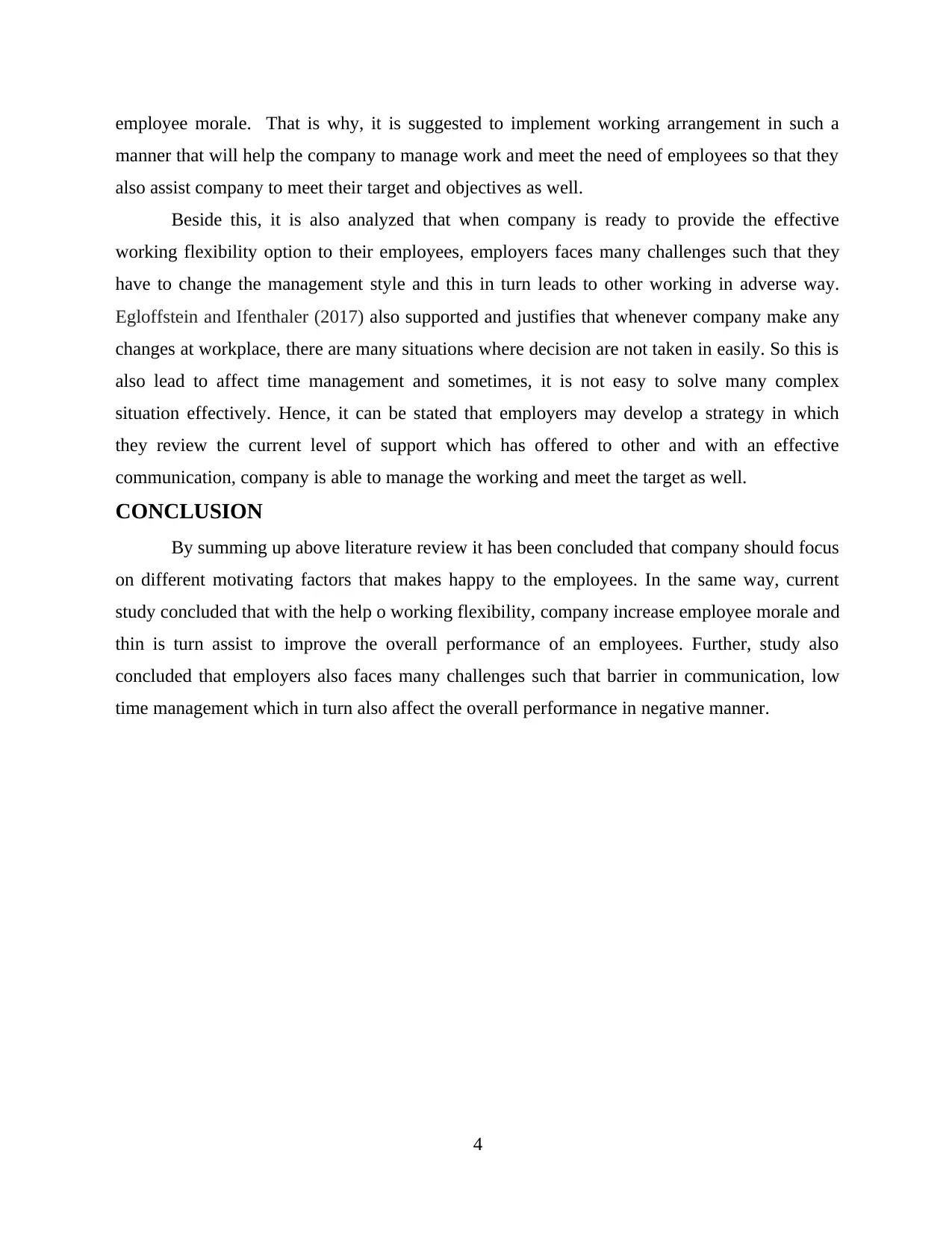
employee morale. That is why, it is suggested to implement working arrangement in such a
manner that will help the company to manage work and meet the need of employees so that they
also assist company to meet their target and objectives as well.
Beside this, it is also analyzed that when company is ready to provide the effective
working flexibility option to their employees, employers faces many challenges such that they
have to change the management style and this in turn leads to other working in adverse way.
Egloffstein and Ifenthaler (2017) also supported and justifies that whenever company make any
changes at workplace, there are many situations where decision are not taken in easily. So this is
also lead to affect time management and sometimes, it is not easy to solve many complex
situation effectively. Hence, it can be stated that employers may develop a strategy in which
they review the current level of support which has offered to other and with an effective
communication, company is able to manage the working and meet the target as well.
CONCLUSION
By summing up above literature review it has been concluded that company should focus
on different motivating factors that makes happy to the employees. In the same way, current
study concluded that with the help o working flexibility, company increase employee morale and
thin is turn assist to improve the overall performance of an employees. Further, study also
concluded that employers also faces many challenges such that barrier in communication, low
time management which in turn also affect the overall performance in negative manner.
4
manner that will help the company to manage work and meet the need of employees so that they
also assist company to meet their target and objectives as well.
Beside this, it is also analyzed that when company is ready to provide the effective
working flexibility option to their employees, employers faces many challenges such that they
have to change the management style and this in turn leads to other working in adverse way.
Egloffstein and Ifenthaler (2017) also supported and justifies that whenever company make any
changes at workplace, there are many situations where decision are not taken in easily. So this is
also lead to affect time management and sometimes, it is not easy to solve many complex
situation effectively. Hence, it can be stated that employers may develop a strategy in which
they review the current level of support which has offered to other and with an effective
communication, company is able to manage the working and meet the target as well.
CONCLUSION
By summing up above literature review it has been concluded that company should focus
on different motivating factors that makes happy to the employees. In the same way, current
study concluded that with the help o working flexibility, company increase employee morale and
thin is turn assist to improve the overall performance of an employees. Further, study also
concluded that employers also faces many challenges such that barrier in communication, low
time management which in turn also affect the overall performance in negative manner.
4
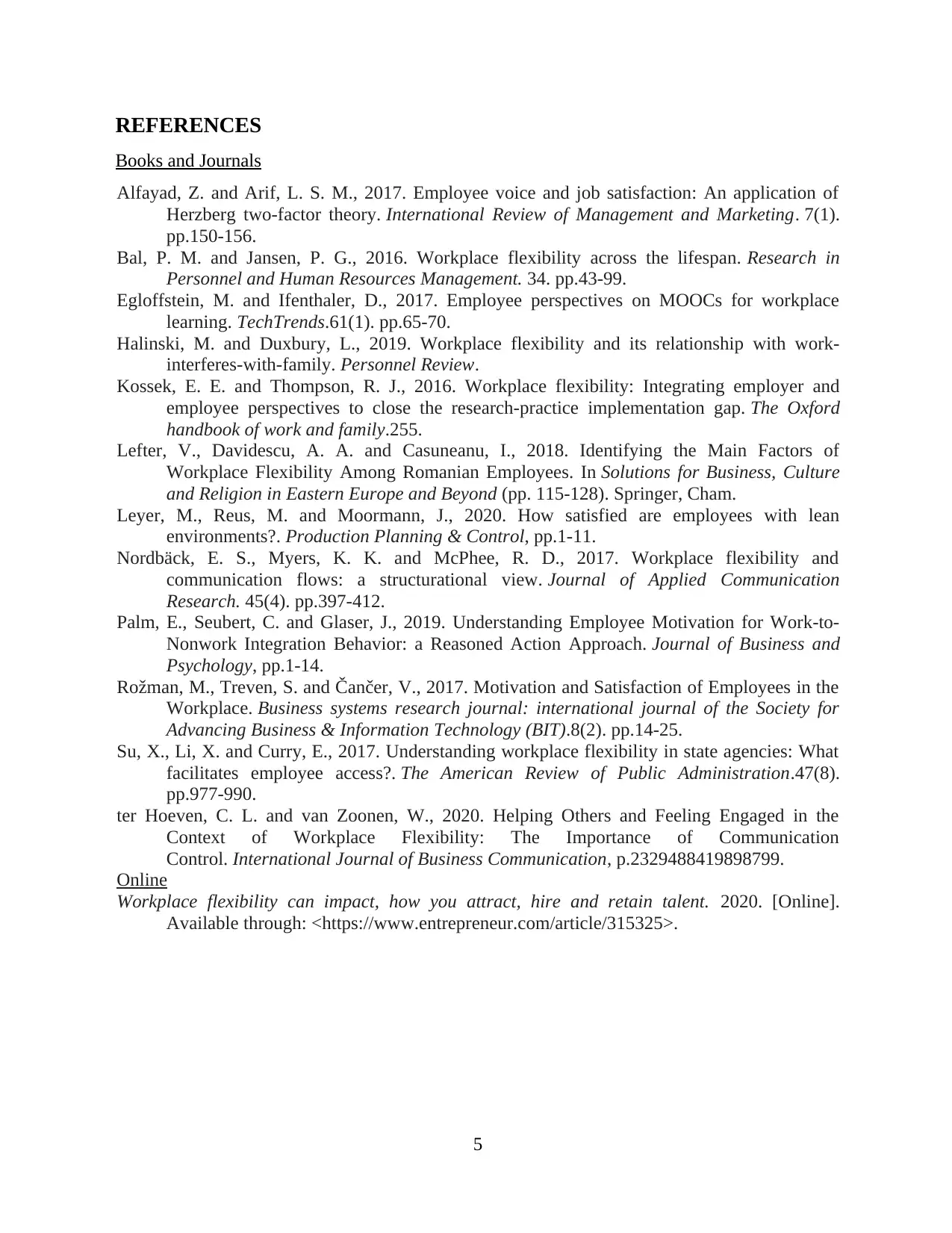
REFERENCES
Books and Journals
Alfayad, Z. and Arif, L. S. M., 2017. Employee voice and job satisfaction: An application of
Herzberg two-factor theory. International Review of Management and Marketing. 7(1).
pp.150-156.
Bal, P. M. and Jansen, P. G., 2016. Workplace flexibility across the lifespan. Research in
Personnel and Human Resources Management. 34. pp.43-99.
Egloffstein, M. and Ifenthaler, D., 2017. Employee perspectives on MOOCs for workplace
learning. TechTrends.61(1). pp.65-70.
Halinski, M. and Duxbury, L., 2019. Workplace flexibility and its relationship with work-
interferes-with-family. Personnel Review.
Kossek, E. E. and Thompson, R. J., 2016. Workplace flexibility: Integrating employer and
employee perspectives to close the research-practice implementation gap. The Oxford
handbook of work and family.255.
Lefter, V., Davidescu, A. A. and Casuneanu, I., 2018. Identifying the Main Factors of
Workplace Flexibility Among Romanian Employees. In Solutions for Business, Culture
and Religion in Eastern Europe and Beyond (pp. 115-128). Springer, Cham.
Leyer, M., Reus, M. and Moormann, J., 2020. How satisfied are employees with lean
environments?. Production Planning & Control, pp.1-11.
Nordbäck, E. S., Myers, K. K. and McPhee, R. D., 2017. Workplace flexibility and
communication flows: a structurational view. Journal of Applied Communication
Research. 45(4). pp.397-412.
Palm, E., Seubert, C. and Glaser, J., 2019. Understanding Employee Motivation for Work-to-
Nonwork Integration Behavior: a Reasoned Action Approach. Journal of Business and
Psychology, pp.1-14.
Rožman, M., Treven, S. and Čančer, V., 2017. Motivation and Satisfaction of Employees in the
Workplace. Business systems research journal: international journal of the Society for
Advancing Business & Information Technology (BIT).8(2). pp.14-25.
Su, X., Li, X. and Curry, E., 2017. Understanding workplace flexibility in state agencies: What
facilitates employee access?. The American Review of Public Administration.47(8).
pp.977-990.
ter Hoeven, C. L. and van Zoonen, W., 2020. Helping Others and Feeling Engaged in the
Context of Workplace Flexibility: The Importance of Communication
Control. International Journal of Business Communication, p.2329488419898799.
Online
Workplace flexibility can impact, how you attract, hire and retain talent. 2020. [Online].
Available through: <https://www.entrepreneur.com/article/315325>.
5
Books and Journals
Alfayad, Z. and Arif, L. S. M., 2017. Employee voice and job satisfaction: An application of
Herzberg two-factor theory. International Review of Management and Marketing. 7(1).
pp.150-156.
Bal, P. M. and Jansen, P. G., 2016. Workplace flexibility across the lifespan. Research in
Personnel and Human Resources Management. 34. pp.43-99.
Egloffstein, M. and Ifenthaler, D., 2017. Employee perspectives on MOOCs for workplace
learning. TechTrends.61(1). pp.65-70.
Halinski, M. and Duxbury, L., 2019. Workplace flexibility and its relationship with work-
interferes-with-family. Personnel Review.
Kossek, E. E. and Thompson, R. J., 2016. Workplace flexibility: Integrating employer and
employee perspectives to close the research-practice implementation gap. The Oxford
handbook of work and family.255.
Lefter, V., Davidescu, A. A. and Casuneanu, I., 2018. Identifying the Main Factors of
Workplace Flexibility Among Romanian Employees. In Solutions for Business, Culture
and Religion in Eastern Europe and Beyond (pp. 115-128). Springer, Cham.
Leyer, M., Reus, M. and Moormann, J., 2020. How satisfied are employees with lean
environments?. Production Planning & Control, pp.1-11.
Nordbäck, E. S., Myers, K. K. and McPhee, R. D., 2017. Workplace flexibility and
communication flows: a structurational view. Journal of Applied Communication
Research. 45(4). pp.397-412.
Palm, E., Seubert, C. and Glaser, J., 2019. Understanding Employee Motivation for Work-to-
Nonwork Integration Behavior: a Reasoned Action Approach. Journal of Business and
Psychology, pp.1-14.
Rožman, M., Treven, S. and Čančer, V., 2017. Motivation and Satisfaction of Employees in the
Workplace. Business systems research journal: international journal of the Society for
Advancing Business & Information Technology (BIT).8(2). pp.14-25.
Su, X., Li, X. and Curry, E., 2017. Understanding workplace flexibility in state agencies: What
facilitates employee access?. The American Review of Public Administration.47(8).
pp.977-990.
ter Hoeven, C. L. and van Zoonen, W., 2020. Helping Others and Feeling Engaged in the
Context of Workplace Flexibility: The Importance of Communication
Control. International Journal of Business Communication, p.2329488419898799.
Online
Workplace flexibility can impact, how you attract, hire and retain talent. 2020. [Online].
Available through: <https://www.entrepreneur.com/article/315325>.
5
1 out of 7
Related Documents
Your All-in-One AI-Powered Toolkit for Academic Success.
+13062052269
info@desklib.com
Available 24*7 on WhatsApp / Email
![[object Object]](/_next/static/media/star-bottom.7253800d.svg)
Unlock your academic potential
© 2024 | Zucol Services PVT LTD | All rights reserved.





